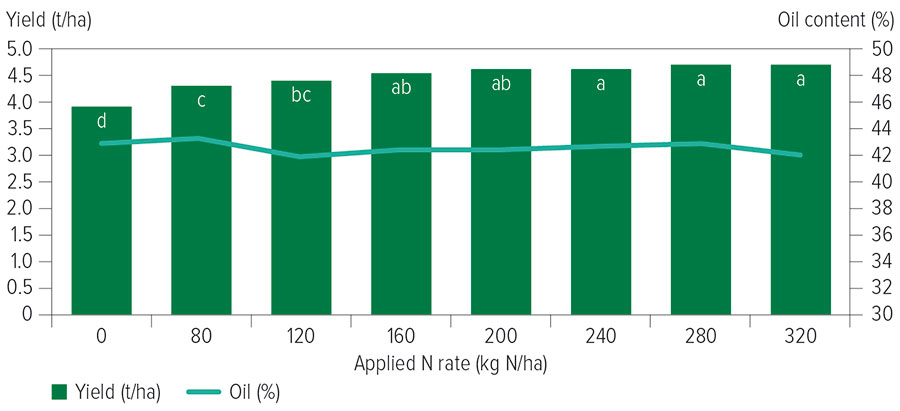Canola production under irrigation faces unique risks, so metrics are being developed to guide management decisions.
Irrigated cropping provides opportunities to intensify production, but while technological innovation has increased the efficiency of irrigated agriculture, significant potential still exists for improvement.
That is why GRDC invested in a three-year project with Field Applied Research (FAR) Australia considering ways to lift the productivity and profitability of irrigated farming systems in south-eastern Australia.
“Highly volatile climatic conditions, water costs and water allocations – often linked to seasonal and political contexts – demand more-informed crop and irrigation choices at the outset of the growing season,” says FAR Australia’s managing director, Nick Poole.
FAR Australia established trials at Finley, New South Wales and – with collaborating partner the Irrigated Cropping Council – at Kerang in Victoria to take a close look at management practices of cereals, pulses and canola under surface and overhead irrigation.
We are developing an understanding around what drives yield in irrigated cropping systems and metrics will provide a focus for further improvements.
“To do this, we are teasing apart canola’s yield and profitability response to different plant populations, nitrogen rates and timing and the effect of plant growth regulators under the two types of irrigation,” Mr Poole says.
The two sites provide contrasting environments as they differ in soil type and temperature profile. But both provide the same risks and challenges for irrigated canola production.
Plant population metrics
“Irrigation does not protect you from establishment risks when growing canola,” Mr Poole says.
If you wet up a profile prior to sowing, you can face the risk of waterlogging come autumn if you get large rainfall events and this will impair canola establishment.
Preliminary results showed varieties performing differently under the two irrigation regimes. Using overhead irrigation (125 millimetres applied in five applications of 25mm), significant plant population and cultivar interactions occurred. For example, Pioneer® 45Y28 RR showed no significant difference in seed yield as plant population increased from 14 to 36 plants per square metre. In contrast, Nuseed HyTTec® Trophy achieved the highest yields with the highest population (3.92 tonnes per hectare from 30 plants/m2, sown at 80 seeds/m2).
In contrast, with increasing surface irrigation (240mm from three applications of 80mm) and higher available soil nitrogen (214 kilograms of nitrogen per hectare, zero to 90 centimetres), seed yields were higher and both cultivars achieved highest yields at the highest plant populations (Pioneer® 45Y28 RR – 4.9t/ha, 32 plants/m2; Nuseed HyTTec® Trophy – 4.01 to 4.11t/ha, 23 to 31 plants/m2).
Nitrogen metrics
“A common nitrogen budget metric used for Australian dryland crops is that for every tonne of canola we need approximately 80kg of nitrogen/ha,” Mr Poole says.
“So under irrigated conditions, if we consider producing a 5t/ha canola crop, we need to supply 400kg of nitrogen/ha from a combination of either fertiliser and/or the soil. The risk in irrigated systems is spending too much on nitrogen fertiliser with no yield gain.”
Nitrogen trials at both the Finley and Kerang sites applied rates of up to 320kg of nitrogen/ha. Preliminary results show it was not possible to produce higher canola yield by simply applying more nitrogen fertiliser; 120 to 160kg/ha was optimum (Figure 1).
Figure 1: Canola yield and oil content under different nitrogen treatments and overhead irrigation at the Finley, NSW site. Soil nitrogen available at sowing = 129 kilograms of nitrogen per hectare (0 to 90 centimetres)
 Source: FAR Australia
Source: FAR Australia
“But, importantly, canola takes out more nitrogen with the combined canopy and seed yield than is applied in fertiliser. We have seen this when we grow wheat subsequently on these canola trials, as there are visually deficient plots compared to plots with the highest nitrogen rates.
“This is where we need to consider the fertility of our farming systems as a whole. Whether we apply extra nitrogen, so it will be available for crops the following season, or whether we include other sources of nitrogen such as grain legumes, organic manures or pasture legumes in our crop sequences.”
More information: Nick Poole, 0499 888 066, nick.poole@faraustralia.com.au
Fort in depth trial information, visit FARs Trial reports.

























































